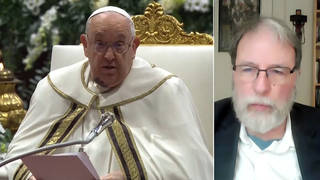
Guests
- Ali Kazimifilmmaker, writer, scholar and visual artist who is the chair of the Department of Cinema & Media Arts at York University. He is the author Undesirables: White Canada and the Komagata Maru and made an award-winning documentary on the Komagata Maru incident, Continuous Journey.
Broadcasting from Toronto, Canada, we look at how Canadian Prime Minister Justin Trudeau formally apologized this week for the 1914 Komagata Maru incident in which Canada turned away a Japanese steamship in order to prevent more than 370 Indians, including Sikhs, Muslims and Hindus, from immigrating to the country. The move was widely acknowledged to be aimed at keeping Indians out of Canada. Then premier of British Columbia, Sir Richard McBride, said at the time, “And we always have in mind the necessity of keeping this a white man’s country.” We feature excerpts from the award-winning documentary on the Komagata Maru incident, “Continuous Journey,” and speak with its director, Ali Kazimi, who is also author of the book, “Undesirables: White Canada and the Komagata Maru.” Kazimi also discusses Canada’s current practice of detaining asylum seekers after a string of deaths inside detention centers.
Transcript
AMY GOODMAN: We’re on the road in Toronto, Canada, broadcasting from the studios of the Canadian Broadcasting Corporation, the CBC. Canadian Prime Minister Justin Trudeau has formally apologized for the 1914 Komagata Maru incident, in which Canada turned away a Japanese steamship in order to prevent more than 370 Indians, including six Muslims and Hindus, from immigrating to Canada. The move was widely acknowledged to be aimed at keeping Indians out of Canada. Then premier of British Columbia, Sir Richard McBride, said at the time, quote, “we always have in mind the necessity of keeping this a white man’s country.” Well, on Wednesday, more than a century after the boat was turned away, Prime Minister Justin Trudeau apologized.
PRIME MINISTER JUSTIN TRUDEAU: Mr. Speaker, today I rise in this house to offer an apology on behalf of the government of Canada for our role in the Komagata Maru incident. … More than a century ago, a great injustice took place. On May 23rd, 1914, a steamship sailed into Burrard Inlet in Vancouver. On board were 376 passengers of Sikh, Muslim and Hindu origin. Those passengers, like millions of immigrants to Canada before and since, came seeking better lives for their families, greater opportunities, a chance to contribute to their new home. Those passengers chose Canada. When they arrived here, they were rejected.
No words can erase the pain and suffering they experienced. Regrettably, the passage of time means that none are alive to hear our apology today. Still, we offer it fully and sincerely, for our indifference to your plight, for our failure to recognize all that you had to offer, for the laws that discriminated against you so senselessly, and for not apologizing sooner. For all these things, we are truly sorry. … Just as we apologize for past wrongs, so, too, must we commit ourselves to positive action, to learning from the mistakes of the past and to making sure that we never repeat them. That is the unique promise and potential of Canada.
AMY GOODMAN: That was Canadian Prime Minister Justin Trudeau speaking on Wednesday, formally apologizing for the 1914 Komagata Maru incident. The tragedy of the Komagata Maru was told in the 2004 documentary Continuous Journey. This is a part of the film’s trailer.
ALI KAZIMI: May 23rd, 1914, immigration officers surround the Komagata Maru and anchor it one kilometer from shore. No one can land. The press is barred. No reasons are given. Who are these men? They are farmers, at sea for two long months. They are British subjects finally reaching the shores of a British dominion. They believe they can go anywhere in the empire.
AUDREY MACKLIN: One of the most powerful myths of the British Empire promoted by imperial interests was the assertion that all British subjects are equal within and throughout the empire. The attempts by Canada to exclude South Asians from entering had the potential to explicitly explode that myth.
HUGH JOHNSTON: There couldn’t really be an open policy of exclusion. It had to be a concealed one. It had to be one that could be denied.
ALI KAZIMI: In 1908, Prime Minister Laurier asked a young bureaucrat, Mackenzie King, to design such a veiled policy. Mackenzie King was clear in his confidential report.
WILLIAM LYON MACKENZIE KING: [quoted] “[T]hat Canada should remain a White man’s country is believed to be not only desirable … but highly necessary on political and [social] grounds.”
AMY GOODMAN: That was part of the trailer for the award-winning documentary on Komagata Maru incident called Continuous Journey. For more, we’re joined here in Toronto, Canada, by its director, Ali Kazimi. He’s a filmmaker, writer, scholar and visual artist. He’s also the chair of the Department of Cinema & Media Arts at York University and author of the book, Undesirables: White Canada and the Komagata Maru. On Wednesday, Ali Kazimi was in the audience when Canadian Prime Minister Justin Trudeau formally apologized.
Ali, welcome to Democracy Now!
ALI KAZIMI: Thank you for having me.
AMY GOODMAN: Talk about the significance of the Canadian prime minister’s apology a hundred years after what took place.
ALI KAZIMI: I think it’s significant. We just heard over and over again in the clips and in your quote that Canada was imagined as a white man’s country, and that assertion was repeated during the debates in the House of Commons a hundred years ago and even before that. So, from 1867 to 1967, I assert that Canada had what was effectively a whites-only immigration policy. And one of the instruments of keeping the country a white man’s country was the continuous journey regulation, which prevented the Komagata Maru.
AMY GOODMAN: Why was it called “continuous journey”?
ALI KAZIMI: You had to come by continuous journey from your country of nationality or origin. And this was specifically designed for South Asians, because, remember, at that time Canada was part of the British Empire, and what the imperial authorities were worried about is that if Canada denied British—fellow British subjects, Indians, the right to enter, India would go up in flames. This was a very real fear. So a policy had to be designed that was veiled. So, Mackenzie King, who later became Canada’s one of the longest-standing prime ministers, designed a policy which said you just had to come by continuous journey. It made no mention of race or nationality, and that—therein lies its brilliance. And therefore, it’s been ignored by historians as being an instrument of racial exclusion.
AMY GOODMAN: At the time of the Komagata Maru incident in 1914, Malcolm Reid was the dominion immigration agent, Canada’s West Coast gatekeeper. He laid siege to the Komagata Maru. The man who had appointed Reid and gave him orders resided in Ottawa, federal member of Parliament H.H. Stevens. In this clip from Ali Kazimi’s documentary, Continuous Journey, we begin with an actor recreating H.H. Stevens’ views on Hindus.
ALI KAZIMI: H.H. Stevens.
H.H. STEVENS: [quoted] “A Hindu never did one solitary thing for humanity in the past 2,000 years and will probably not in the next 2,000.”
HUGH JOHNSTON: H.H. Stevens was a strong opponent of Asian immigration. And, of course, his voters supported his position.
AUDREY MACKLIN: It was absolutely a part of the nation-building project for Canada both to say, “These are people who can become Canadian, these are people who cannot. That’s part of how we define ourselves as a nation,” and, on top of that, to say, “And we have the power to exercise that.”
AMY GOODMAN: I want to go to another clip from the documentary, Continuous Journey. Here we learn how Canada discriminated against particular immigrants depending on their alleged desirability.
ALI KAZIMI: Panic had been building in Vancouver since the early days, when shiploads of Indian immigrants started arriving. The authorities did everything they could to discourage them from settling in Canada.
ENA DUA: It was very clear that politicians were talking about a white Canada policy. It was proclaimed every day in newspapers. It was proclaimed in Parliament. You know, John A. Macdonald, in his—one of his first speeches to Parliament, got up and said, “Canada is a white man’s country. We will create immigration policies to create a white man’s country.”
ALI KAZIMI: The anti-Asian riots in 1907 forced the Laurier government into action. But it had to be careful. Canada was still stuck in the empire.
AUDREY MACKLIN: Canada, as such, doesn’t control its own foreign policy. To understand then what measures Canada takes regarding the entry of foreign nationals into Canada itself, you have to take into account how Britain would view those policies in terms of its larger imperial interests.
HUGH JOHNSTON: China at that time was, on the international scene, a weak state. And Chinese citizens, to get into Canada, were obliged to pay a head tax. And this exclusion by head tax was insulting. But because the Chinese didn’t have the diplomatic weapons to counter that, that’s what Canada did.
AMY GOODMAN: That’s a clip from the film Continuous Journey. Ali Kazimi, the director, filmmaker, writer, scholar, continue on what we just heard. Also, interesting how they talk about Hindus; in fact, the vast majority of people on this boat were not Hindu, but Sikh.
ALI KAZIMI: That’s right. And I think the term “Hindu” was used to describe people from India at that point. It was a distinction made because—to avoid confusion between the indigenous peoples of Canada, the so-called Indians at the time, and so anyone coming from South Asia who was brown, who wore a turban—and many, many South Asians who were not Sikhs also wore turbans at that point—were simply labeled as Hindus.
AMY GOODMAN: So talk about how you got interested in this, Ali.
ALI KAZIMI: I came to Canada in '83. And when I arrived at the airport, the immigration officer took me aside for interrogation. I came here as a foreign student to attend York University, where I'm the chair now. And one of the things he said to me after interrogating me was, “The only reason I’m letting you into my country is because you speak such good English.” And I thought, “Wow! This is an interesting moment.” The power of the immigration officer as a gatekeeper was driven home. And then, as I tried to make Canada my home, I was trying to see: How do I fit into this Canadian landscape? And in exploring early Canadian immigration history, I found the answer to the question, “If Canadians see themselves as inclusive, multicultural always, why do the Canadian demographics don’t reflect that?” Because, largely, Canada is still a white country—with increasing diversity, but that hasn’t always been the case. And that took me to all these politely referred to as exclusionary policies, which were, in fact, racist immigration laws.
AMY GOODMAN: So let’s get to the end of what happens. I want to go back to your documentary, Ali Kazimi, Continuous Journey. And here we learn how the Komagata Maru incident ends: with some 26 people killed and more than two dozen passengers listed as missing.
ALI KAZIMI: On September 26th, two months after heading out from Vancouver, the Komagata Maru reaches the coast of India. As I traveled through what used to be East Bengal, now Bangladesh, I can’t help thinking about their return. Once again, the Komagata Maru must anchor just off the coast. Imperial authorities are convinced the passengers are Ghadarites. For three days, they comb the ship for weapons and find nothing. On the 29th of September, the ship is diverted to the town of Baj Baj, 27 kilometers short of its final destination, Calcutta. The passengers see this as another trick. Tension is running high. As soon as they land on Indian soil, British troops surround them. A scuttle breaks out. Gurdit Singh’s son is snatched away from his father.
BALWANT SINGH: I understood at once the meaning of this act. Then, to our horror, we felt police bullets hitting us. No warning was given for this unprovoked attack. Three or four of my men lifted me on their shoulders and carried me to safety. I protested, but they replied, “Alive, you will tell the sad story of the Komagata Maru.”
AMY GOODMAN: Ali Kazimi, take it from there, from your documentary, Continuous Journey. What happened at the end?
ALI KAZIMI: In the end, many of the people on the—the survivors, after the shooting, were arrested. Many were treated as seditious revolutionaries.
AMY GOODMAN: And explain exactly where the shooting happened.
ALI KAZIMI: The shooting happened in the village of Baj Baj, which is 26 kilometers away from Calcutta, the port of Calcutta, where the ship was sent back. And the authorities felt that these people, many of whom were returning veterans of the British Indian Army, were going to cause another mutiny in the British Indian Army. This is the thought that terrified the British, when India was immersed in the First World War by the time the ship got back, and the Indian Army was the largest volunteer force, of over 1 million men, to serve in the First World War. And the British couldn’t afford to lose India, nor could they afford to lose this immense force on their side in the First World War.
Meanwhile in Canada, the continuous journey regulation, which was used to turn the ship away, was an absolute regulation. We had something called the Chinese Exclusion Act, which mirrored what happened in the U.S. But the Chinese Exclusion Act was not as absolute as the continuous journey regulation, which effectively blocked immigration [to] Canada ’til 1948. And Canada did not drop its race-based immigration laws ’til 1967.
AMY GOODMAN: Right now Canada is dealing with major refugee stories. In the headlines today, Prime Minister Trudeau continuing to—in the headlines today, you had the Canadian government pledging to examine its own practice of detaining asylum seekers, after a string of deaths inside detention centers. Can you relate the two?
ALI KAZIMI: Absolutely, Amy. One of the things that happened with the Komagata Maru was that the passengers were detained outside the rule of law, for two months. They suffered what is happening to the detainees right now who are being held in indefinite detention outside—you know, without due process. Women and children are being held in detention in Canada. The same thing happened on the Komagata Maru. There were women and children on board the ship who were driven to the edge of thirst and starvation, deliberately, by the immigration authorities.
There are many patterns that continue to this day. Canada, for example, has signed an agreement with the United States called the Safe Third Country Agreement, which says that refugees must come by direct journey from the country of persecution to Canada, and if they don’t, they will have to seek asylum in the safe third country that they pass through. The vast majority of refugees to Canada come through the U.S. border. And now, by blocking the border since 2003, Amnesty International has condemned Canada for the Safe Third Country Agreement, which has led to a massive drop, a huge drop, in refugee applications to Canada. So, these—the continuous journey regulation, on the one hand, has been apologized for, but there are echoes of it in ongoing Canadian immigration and refugee policies.
AMY GOODMAN: Now, Ali Kazimi, if you asked most Canadians about this apology on Wednesday, they might not even have noticed, because it’s been subsumed by another apology, an incident that happened on the same day in the Commons, where you were, a reception then taking place where Prime Minister Trudeau was, and that’s what happened with Prime Minister Trudeau trying to manhandle a Conservative member of the Parliament and in trying to get him to sit down so they could vote on assisted dying. And when he was doing this, he inadvertently elbowed a female member of the Parliament. And this has just subsumed all the coverage of everything, it seems, right now in Canada. You were there when Prime Minister Trudeau said to you this would probably happen, to the group of you at the reception for this apology.
ALI KAZIMI: Yeah. I was invited to be one of the witnesses to the apology. And then, as the day progressed, we went from one event to the other. The day ended with a reception for—at which the prime minister came. And we had, by this time, totally lost track of what was happening in the House. He then proceeded to apologize and allude to an event that had happened in the House, which he predicted would take over the news of the apology. And then he, in turn, apologized again and said, “I regret that this has happened, and I am going to be at the center of this, and this is going to take over what we have just achieved today.” And he was quite prophetic about it. And there we are, you know?
AMY GOODMAN: How important is it for Canadians to know what took place a century ago?
ALI KAZIMI: I think it’s extremely important for Canadians to know what took place a century ago, because this is not just South Asian history, it’s Canadian history. It forces us to re-examine our own self-image as somehow this country that is quite different and above what happens in the U.S. Race makes people incredibly uncomfortable in Canada. And any idea that these kind of incredibly racist and deliberately designed laws existed in the country is still not widely known in Canada. And one of the things about the apology was that, you know, in an apology, both sides have to know what happened.
AMY GOODMAN: Do you see this as Canada’s “Voyage of the Damned,” the MS St. Louis, which took 900 Jews away from Nazi Germany? They tried to get into Cuba; they were denied entry. They tried to get into the U.S.; they were denied entry. And they also tried to get into Canada.
ALI KAZIMI: They tried to get into Canada, yes. And the St. Louis was the second ship to be turned away, the first being the Komagata Maru. So this was the pattern that Canada has in its history. And it’s a pattern based on the notion of white superiority. And that, Canada has to confront and has to face head-on, and we haven’t done that so far. The apology goes some part in addressing that. I’m glad the prime minister did not stop at just—that this was just about this one incident. I’m glad that he acknowledged that there were discriminatory laws.
And I think what was even more important for me, that the members—the leaders of the opposition took it a step further, and they said that these were—”Let’s name it: These were racist immigration laws.” And so the idea of race entered the House of Commons and was talked about. That pleased me. And the leader of the NDP then connected it to what happened to a boatload—a shipload of Tamil refugees who came four years ago on a ship called the MV Sun Sea, who were subjected to very similar conditions, beyond the rule of law, by the then-Conservative government. They were put in hazmat suits. They were denied access to lawyers. They were detained indefinitely. They were denied access to the press. This is exactly what happened to the Komagata Maru.
AMY GOODMAN: I want to thank you, Ali Kazimi, for joining us, filmmaker, writer, scholar, visual artist. He’s the chair of the Department of Cinema & Media Arts at York University. His book, Undesirables: White Canada and the Komagata Maru. We’ll be back in a minute.
[break]
AMY GOODMAN: “Crossing the Pacific: The Hopes of 376 Passengers” by Neelamjit Dhillon Quartet.













Media Options